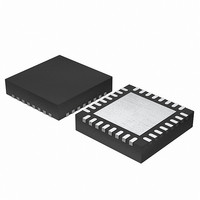EFM32G200F16 Energy Micro, EFM32G200F16 Datasheet - Page 146

EFM32G200F16
Manufacturer Part Number
EFM32G200F16
Description
MCU 32BIT 16KB FLASH 32-QFN
Manufacturer
Energy Micro
Series
Geckor
Datasheets
1.EFM32G200F16.pdf
(63 pages)
2.EFM32G200F16.pdf
(10 pages)
3.EFM32G200F16.pdf
(463 pages)
4.EFM32G200F16.pdf
(136 pages)
Specifications of EFM32G200F16
Core Processor
ARM® Cortex-M3™
Core Size
32-Bit
Speed
32MHz
Connectivity
EBI/EMI, I²C, IrDA, SmartCard, SPI, UART/USART
Peripherals
Brown-out Detect/Reset, DMA, POR, PWM, WDT
Number Of I /o
24
Program Memory Size
16KB (16K x 8)
Program Memory Type
FLASH
Ram Size
8K x 8
Voltage - Supply (vcc/vdd)
1.8 V ~ 3.8 V
Data Converters
A/D 4x12b, D/A 1x12b
Oscillator Type
External
Operating Temperature
-40°C ~ 85°C
Package / Case
32-VQFN Exposed Pad
Processor Series
EFM32G200
Core
ARM Cortex-M3
Data Bus Width
32 bit
Data Ram Size
8 KB
Interface Type
I2C, UART
Maximum Clock Frequency
32 MHz
Number Of Programmable I/os
24
Number Of Timers
2
Operating Supply Voltage
1.8 V to 3.8 V
Maximum Operating Temperature
+ 85 C
Mounting Style
SMD/SMT
Minimum Operating Temperature
- 40 C
Lead Free Status / RoHS Status
Lead free / RoHS Compliant
Eeprom Size
-
Lead Free Status / Rohs Status
Details
- EFM32G200F16 PDF datasheet
- EFM32G200F16 PDF datasheet #2
- EFM32G200F16 PDF datasheet #3
- EFM32G200F16 PDF datasheet #4
- Current page: 146 of 463
- Download datasheet (8Mb)
15.3.1.5 Arbitration, Clock Synchronization, Clock Stretching
15.3.2 Enable and Reset
15.3.3 Safely disabling and changing slave configuration
2010-09-06 - d0001_Rev1.00
When performing a master transmitter operation, the master transmits the two address bytes and then
the remaining data, as shown in Figure 15.8 (p. 146) .
Figure 15.8. I
When performing a master receiver operation however, the master first transmits the two address bytes
in a master transmitter operation, then sends a repeated START followed by the first address byte and
then receives data from the addressed slave. The slave addressed by the 10-bit address in the first two
address bytes must remember that it was addressed, and respond with data if the address transmitted
after the repeated start matches its own address. An example of this, with one byte transmitted is shown
in Figure 15.9 (p. 146) .
Figure 15.9. I
Arbitration and clock synchronization are features aimed at allowing multi-master buses. Arbitration
occurs when two devices try to drive the bus at the same time. If one device drives it low, while the
other drives it high, the one attempting to drive it high will not be able to do so due to the open-drain
bus configuration. Both devices sample the bus, and the one that was unable to drive the bus in the
desired direction detects the collision and backs off, letting the other device continue communication
on the bus undisturbed.
Clock synchronization is a means of synchronizing the clock outputs from several masters driving the
bus at once, and is a requirement for effective arbitration.
Slaves on the bus are allowed to force the clock output on the bus low in order to pause the
communication on the bus and give themselves time to process data or perform any real-time tasks they
might have. This is called clock stretching.
Arbitration is supported by the I
stretching is also supported.
The I
internal state of the I
Note
The I
safe slave disable or configuration change. If the user cannot guarantee that an address match will not
occur at the exact time of slave disable or slave configuration change while the slave is enabled, these
measures should be made.
Worst case consequences for an address match while disabling slave or changing configuration is that
the slave may end up in an undefined state. To reset the slave back to a known state, the EN bit in
S
2
2
ADDR (1st 7 bits)
C is enabled by setting the EN bit in the I2Cn_CTRL register. Whenever this bit is cleared, the
C slave is partially asynchronous, and some precautions may be necessary to always ensure a
When Re-enabling the I
applied prior to use even if the BUSY flag is not set.
S
2
2
C Master Transmitter/Slave Receiver with 10-bit Address
C Master Receiver/Slave Transmitter with 10-bit Address
ADDR (1st 7 bits)
2
C is reset, terminating any ongoing transfers.
W
A
2
Addr (2nd byte)
C module for both masters and slaves. Clock synchronization and clock
2
W
C, the ABORT command or the Bus Idle Timeout feature must be
A
Addr (2nd byte)
...the world's most energy friendly microcontrollers
A
146
Sr
ADDR (1st 7 bits)
A
DATA
R
A
www.energymicro.com
DATA
A
P
N
P
Related parts for EFM32G200F16
Image
Part Number
Description
Manufacturer
Datasheet
Request
R

Part Number:
Description:
KIT STARTER EFM32 GECKO
Manufacturer:
Energy Micro
Datasheet:

Part Number:
Description:
KIT DEV EFM32 GECKO LCD SUPPORT
Manufacturer:
Energy Micro
Datasheet:

Part Number:
Description:
BOARD PROTOTYPING FOR EFM32
Manufacturer:
Energy Micro
Datasheet:

Part Number:
Description:
KIT DEVELOPMENT EFM32 GECKO
Manufacturer:
Energy Micro
Datasheet:

Part Number:
Description:
MCU, MPU & DSP Development Tools TG840 Sample Kit
Manufacturer:
Energy Micro
Datasheet:

Part Number:
Description:
MCU, MPU & DSP Development Tools TG Starter Kit
Manufacturer:
Energy Micro
Datasheet:

Part Number:
Description:
MCU, MPU & DSP Development Tools TG108 Sample Kit
Manufacturer:
Energy Micro

Part Number:
Description:
MCU, MPU & DSP Development Tools TG210 Sample Kit
Manufacturer:
Energy Micro
Datasheet:

Part Number:
Description:
MCU, MPU & DSP Development Tools TG822 Sample Kit
Manufacturer:
Energy Micro
Datasheet:

Part Number:
Description:
MCU, MPU & DSP Development Tools TG230 Sample Kit
Manufacturer:
Energy Micro

Part Number:
Description:
SAMPLE KIT (SMALL BOX - CONTAINING 2 DEVICES)
Manufacturer:
Energy Micro

Part Number:
Description:
SAMPLE KIT (SMALL BOX - CONTAINING 2 DEVICES)
Manufacturer:
Energy Micro










